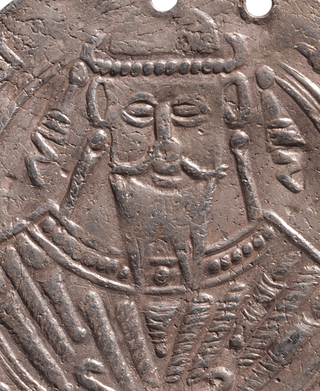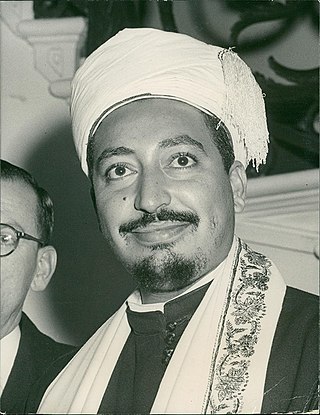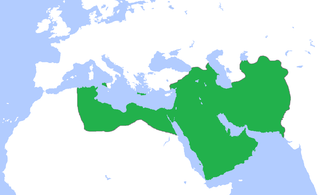Related Research Articles
Zaydism is one of the three main branches of Shia Islam that emerged in the eighth century following Zayd ibn Ali‘s unsuccessful rebellion against the Umayyad Caliphate. Zaydism is typically considered to be a branch of Shia Islam that comes closest to the Sunni, although the "classical" form of Zaydism over the centuries had changed its posture with regard to Sunni and Shia traditions multiple times, to the point where interpretation of Zaydi as Shia is often based on just their acceptance of Ali as a rightful successor to Muhammad. Zaydis regard the rationalism as more important than Quranic literalism and in the past were quite tolerant towards Sunni Shafiism, a religion of about half of the Yemenis.

Ja'far ibn Muhammad ibn Harun ; March 822 – 11 December 861), commonly known by his regnal name al-Mutawwakil ala Allah, was the tenth Abbasid caliph, ruling from 847 until his assassination in 861. He succeeded his brother, al-Wathiq, and is known for expanding the empire to its maximum extent. He was deeply religious, and is remembered for discarding the Muʿtazila, ending the Mihna, and releasing Ahmad ibn Hanbal. He is also known for his tough rule, especially with respect to non-Muslim subjects.

Muhammad Al-Badr was the last king and Zaidi Imam of the Mutawakkilite Kingdom of Yemen and leader of the monarchist regions during the North Yemen Civil War (1962–1970). His full name was Al-Mansur Bi'llah Muhammad Al-Badr bin Al-Nasir-li-dinu'llah Ahmad, Imam and Commander of the Faithful and King of the Mutawakkilite Kingdom of Yemen.

Amr ibn al-Layth or Amr-i Laith Saffari was the second ruler of the Saffarid dynasty of Iran from 879 to 901. He was the son of a whitesmith and the younger brother of the dynasty's founder, Ya'qub ibn al-Layth al-Saffar.
Islam came to Yemen around 630 during Muhammad's lifetime and the rule of the Persian governor Badhan. Thereafter, Yemen was ruled as part of Arab-Islamic caliphates, and became a province in the Islamic empire.

The Imams of Yemen, later also titled the Kings of Yemen, were religiously consecrated leaders (imams) belonging to the Zaidiyyah branch of Shia Islam. They established a blend of religious and temporal-political rule in parts of Yemen from 897. Their imamate endured under varying circumstances until the end of the North Yemen Civil War in 1970, following the republican revolution in 1962. Zaidiyyah theology differs from Isma'ilism and Twelver Shi’ism by stressing the presence of an active and visible imam as leader. The imam was expected to be knowledgeable in religious scholarship, and to prove himself a worthy headman of the community, even in battle if this was necessary. A claimant of the imamate would proclaim a "call" (dawah), and there were not infrequently more than one claimant.

Abūʾl-Ḥusayn Yaḥyā ibn al-Ḥusayn ibn al-Qāsim ibn Ibrāhīm al-Ḥasanī, better known by his honorific title of al-Hādī ilāʾl-Ḥaqq, was a religious and political leader in the Arabian Peninsula. He was the first Zaydi imam who ruled portions of Yemen from 897 to 911. He is also the ancestor of the Rassid Dynasty which ruled Yemen intermittently until the North Yemen Civil War in 1962.
Al-Murtada Muhammad was the second imam of the Zaidi state of Yemen, who ruled from 911 to 912 and was a respected religious scholar.

Al-Mansur al-Qasim al-Iyyani was an imam of the Zaidi state in Yemen who briefly reestablished a comprehensive Zaidi realm in the years 999–1002.
Al-Mansur Yahya was an imam of the Zaidi state in Yemen, whose tenure as imam is counted from 934 to 976.
Al-Mahdī Aḥmad ibn Yaḥyā, or Aḥmad ibn Yaḥyā Ibn al-Murtaḍā, was a Muʿtazila scholar and imam of the Zaidī state in Yemen who briefly held the imamate in 1391–1392. He was an encyclopedist and a prolific writer on a range of subjects.
Al-Mutawakkil al-Mutahhar bin Yahya was an imam of the Zaidi state in Yemen whose imamate lasted from 1276 to 1298.
Al-Mutawakkil Ahmad bin Sulayman (1106–1171) was an imam of the Zaidi state in Yemen who revived the polity after a long interregnum, wielding power in 1138–1171.
Al-Hadi Ali was a claimant to the Zaidi state in Yemen, who posed as imam from 1393 to 1432 in rivalry with another prince.

The Anarchy at Samarra was a period of extreme internal instability from 861 to 870 in the history of the Abbasid Caliphate, marked by the violent succession of four caliphs, who became puppets in the hands of powerful rival military groups.
The Yuʿfirids were an Islamic Himyarite dynasty that held power in the highlands of Yemen from 847 to 997. The name of the family is often incorrectly rendered as "Yafurids". They nominally acknowledged the suzerainty of the Abbasid caliphs. Their centres were San'a and Shibam Kawkaban. The Yuʿfirids followed Sunni Islam.
Nasrallah ibn Muhammad ibn Abd al-Hamid Shirazi, better known as Abu'l-Ma'ali Nasrallah, was a Persian poet and statesman who served as the vizier of the Ghaznavid Sultan Khusrau Malik.
Musa ibn Abi'l-Afiya was a Miknasa Berber chieftain who ruled the western Maghreb for the Fatimid Caliphate before defecting to the Umayyad Caliphate of Córdoba in 931. He played a central role in the Umayyad–Fatimid rivalry of the time, and is also remembered for his persecution of the Idrisids of Morocco.
References
- ↑ Bosworth, C. E.; van Donzel, E.; Heinrichs, W. P. & Pellat, Ch., eds. (1993). The Encyclopaedia of Islam, Second Edition. Volume VII: Mif–Naz. Leiden: E. J. Brill. p. 995. ISBN 978-90-04-09419-2.
- ↑ Ella Landau-Tasseron, 'Zaydi Imams as Restorers of Religion; Ihya and Tajdid in Zaydi Literature', Journal of Near Eastern Studies 49:3 1990, 256.
- ↑ Bosworth, C. E.; van Donzel, E.; Heinrichs, W. P. & Pellat, Ch., eds. (1993). The Encyclopaedia of Islam, Second Edition. Volume VII: Mif–Naz. Leiden: E. J. Brill. p. 996. ISBN 978-90-04-09419-2.
- ↑ H.C. Kay, Yaman; Its Early Medieval History. London 1892, p. 186.